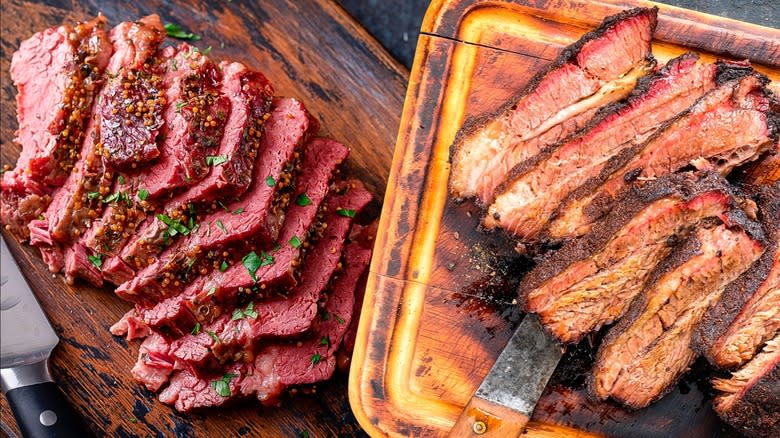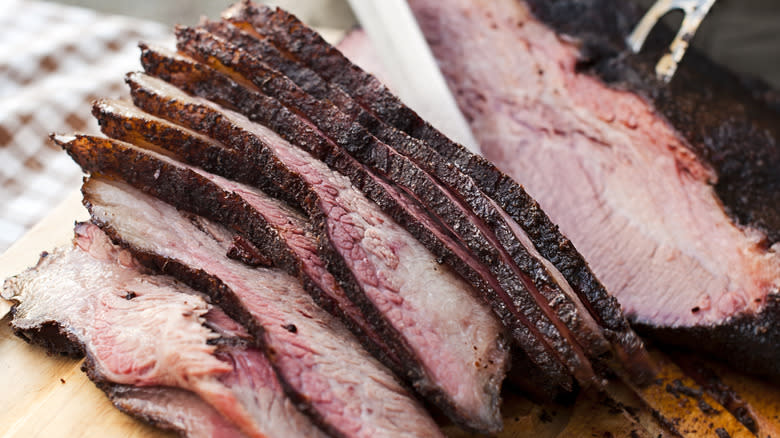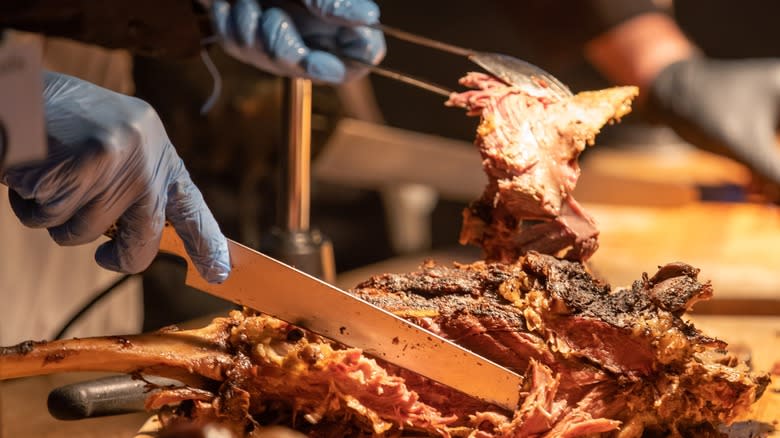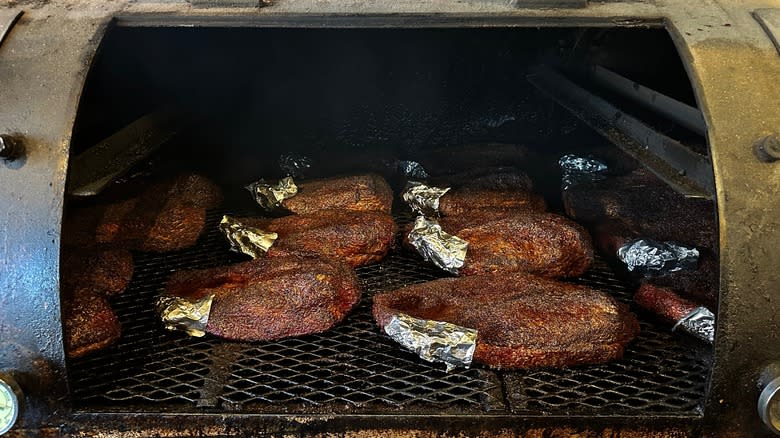What's The Difference Between Corned Beef Vs Brisket?

Corned beef is brisket, but not all brisket is corned beef. It might sound like a math equation, but it's actually more of a culinary lesson. Both meats are commonly used in stews, sandwiches, and braises. Canned corned beef and its hash variant are pantry staples, but you're a lot less likely to spy canned brisket on any grocery store shelf. So, what's the actual difference, here? And where does a curious epicure begin? The "habitat" of these two delicious, oft-interchangeable meats is perhaps their most obvious distinction.
Corned beef is a pillar of New York City's flourishing Jewish deli scene, where it's often served as a thick, stacked sandwich on rye bread with a pickle spear. Zoom down south, and brisket is pulled -- steaming -- off of a smoker with a massive, glinting steak fork at an outdoor barbecue in Texas. But, even though they come from the same cut of meat, brisket and corned beef each have their own flavors, textures, appearances, preparation methods, and lush histories.
Read more: The Most Popular Cuts Of Steak Ranked Worst To Best
What Is Corned Beef?

Perhaps confusingly, corned beef gets its name from the curing salts used to preserve the meat, not from actual corn. Corned beef is made from brisket that has been saltwater-cured. Over the course of days (or weeks), the corned beef absorbs that flavorful, salty brine, not dissimilar to pickling. In addition to salt, the brine is often also loaded with aromatic spices such as cloves, mustard seeds, garlic, black peppercorn, bay leaves, dried red pepper, and coriander.
The average curing time for corned beef is five to eight days soaking in the solution. Although, the world-famous Katz's Deli of NYC corns its beef for a full month. For home cooks, this process can be done in the fridge, but in larger restaurants and delis, barrels of soaking corned beef are often stacked in massive walk-in coolers. Corned beef is one of the oldest enduring types of meat enjoyed by foodies today, as salt-curing was one of the earliest forms of meat preservation before the advent of the refrigerator.
Today, the fan-favorite meat can be found in many if not most grocery stores, and it can be boiled, braised, or roasted. You can make it in a slow cooker, as we do in this Crockpot corned beef recipe, for easy prep on busy weeknights, and you can freeze the leftovers for quick meals in the future. Corned beef is a key player in Irish eggs Benedict, and paired with chopped beets, it becomes another breakfast classic: red flannel hash (a favorite of Bette Davis).
What Is Brisket?

Brisket (not to be confused with chuck roast) comes from the lower chest of a cow or steer, and it is a naturally tough cut of meat. It's the pectoral muscle beneath the first five ribs and behind the foreshank. That's why the cut, which is basically a big roast, is typically barbecued or otherwise slow-cooked to break down the collagen fibers, creating a rich flavor and tender texture.
Brisket can be made in a Crockpot, instant pot, or regular oven, but smoking and grilling are more common methods, as this tough cut benefits from a little more involved, hands-on tending while it cooks. Due to the fact that it really isn't tender or accessible to begin with (the magic happens during the cooking), brisket also tends to be a relatively inexpensive cut of meat.
Still, once it's been softened, this tasty toughie is nothing if not versatile. You can smoke it for 10 hours as we do in this smoked brisket recipe, or hit it with a quick braise and pile it onto some mac and cheese. Or, transform the leftovers into a batch of smoky brisket chili. You can use the tallow to upgrade other recipes, and you can even mix brisket with Wagyu beef tallow for an ultra luxurious, meaty cooking element in other dishes.
Corned Beef Has A More Involved Preparation Method Than Brisket, And It Doesn't Need To Cook As Long

There's a reason why "cooking brisket" conjures images of tong-wielding grill-masters diligently tending a smoker for hours on end. Brisket requires a long, slow cook to soften to a juicy, chewable doneness. Brisket should be cooked long enough to become tender without drying out, retaining all that juicy, succulent moisture during its tenure over the hot coals. Also, the gentle, extended cook facilitates more dimensional flavor development, plus the development of mouth-watering smoky bark on the outside, housing tender, red meat on the inside. This stands in stark contrast to pre-tenderized corned beef.
The extended saltwater brine naturally breaks down some of the muscle fibers in raw corned beef, meaning it cooks to tenderness much more quickly than uncured brisket. Corned beef generally takes one hour to cook per pound, compared to roughly three-and-a-half hours for a full brisket flat. On the far end of the smoky spectrum, Texas-style smoked brisket is cooked for eight to 12 hours at 225 degrees Fahrenheit. However, this convenience comes with a price tag to match. Due to the more involved preparation (i.e. the saltwater cure and spice infusion), corned beef tends to be pricier than brisket at the grocery store or butcher shop.
Brisket Is Robust, Smoky, And Dark, While Corned Beef Is Tangy, Sweet, And Bright Pink

As a result of their different cooking methods and pre-cook preparations, brisket and corned beef tote wildly different flavors and textures. Brisket flavor is smoky, savory, and robust. This tougher cut relies more heavily on secondary seasonings, wood chips, and cooking process (i.e. smoking and barbecuing) to impart flavor, because the muscular meat itself is subjected to little alteration before it gets slammed on the grill. Corned beef, by contrast, is already chewy and moist before it gets cooked.
Corned beef's flavor is sweet, umami, tangy, salty, and a little sharp. Also notably, the two meats are super similar in appearance, but corned beef is more reddish-pink in color than brisket, which tends to lean deeper red or purple-gray. Corned beef's signature bright pink hue comes from the salt-nitrite blend added to the brisket as it's cured to prevent spoilage during the brining process. This blend is the same ingredient responsible for the bright red-pink tinge in other cured meats like hot dogs, ham, salami, and bacon.
Corned Beef Has Connections To Ireland And Jewish New York

It would seem inappropriate to talk about corned beef at any length without mentioning its link to Ireland and St. Patrick's Day. Indeed, the corned beef fans know and love today is a product of its centuries-old history. Corned beef and cabbage traces back to early medieval Ireland, where it was eaten by both peasants and kings. Its connection to St. Patrick's Day comes from early Irish American immigrants.
The Great Famine of the 1840s caused a massive spike in Irish immigration to the U.S. An estimated 1.2 million folks came from Ireland to American shores from 1847 to 1854 alone, primarily landing in Boston, New York, and Philadelphia. Meanwhile, from 1820 to 1924, a mass exodus of over 2.5 million Jewish immigrants from eastern and central Europe was coming to America and settling in New York, Philadelphia, and Baltimore. During the late 1800s to early 1900s, Jewish and Irish immigrants were neighbors in the same overcrowded urban cities, living on top of each other and inadvertently blending cultures.
Kosher butcher shops lined Manhattan's Lower East Side, where new Irish American foodies were doing their shopping. Lower-cost brisket was accessible to poorer families, and corned beef and cabbage was filling. President Lincoln even served corned beef, potatoes, and cabbage at his first Inaugural Luncheon on March 4, 1861. When Lincoln took office in 1861, it was the first era when Irish Americans comprised a significant number of the nation's constituency.
Brisket And Southern American Barbecue Culture

Smoked brisket is the official state dish of Texas, but it's also a traditionally kosher cut of meat. Beef hind quarter isn't kosher unless the sciatic nerve is removed, which "steers" (pun intended) foodies with dietary restrictions toward the forequarter of the cow, including the brisket. Nowadays, brisket is a staple of central Texas barbecue culture. But, before that, it was the early 1900s, and German and Czech immigrants were arriving in central Texas for the first time.
These intrepid foodies spotted the opportunity for butcher and grocery shops in the area due to the state's large population of cows. Central and eastern European Ashkenazi Jewish people from Lithuania, Ukraine, and Galicia attracted to the sprawling land in the American South immigrated thusly, and just like that, folks who had long been enjoying brisket as a kosher dish for Passover, Shabbat, Rosh Hashanah, and Hanukkah brought brisket to Texas. The rest is (literally) history, and Texas barbecue has since taken on a regional culture all its own.
As Aaron Franklin, the James Beard Award-winning owner of Franklin Barbecue, explains via MasterClass: "Traditionally, Texas barbecue is just meat, bread, maybe a slice of tomato, maybe a pickle, maybe a slice of onion." Although, different regional brisket styles have even cropped up within the state. Whereas central Texas keeps it understated and simple, east Texas slathers its brisket in sweet-tangy barbecue sauce, and south Texas kicks up the spiciness with seasonings like cumin, garlic, and chili powder.
Read the original article on Tasting Table.

 Yahoo Lifestyle
Yahoo Lifestyle 
